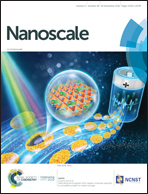Predicting lanthanide boride inverse sandwich tubular molecular rotors with the smallest core–shell structure†
Abstract
Lanthanide–boron binary clusters possess interesting structures and bonding which may provide insights into designing new boride nanomaterials. Inspired by the recently discovered mono-decker inverse sandwich D9h La2B9− (1A′1) (1) and based on the extensive first-principles theory calculations, we predict herein the possible existence of a series of bi-decker inverse sandwich di-lanthanide boron complexes including D9d La2[B18] (3A1g) (2), D9d La2[B18]2− (1A1g) (3), and C2h La2[B2@B18] (1Ag) (4) which all contain a tubular Bn ligand (n = 18, 20) sandwiched by two La atoms at the two ends. In these novel clusters, La2[B2@B18] (4) as a tubular molecular rotor with the smallest core–shell structure reported to date in boron-based nanoclusters possesses a B2-bar rotating constantly and almost freely inside the B18 tube around it at room temperature. Detailed bonding analyses indicate that these complexes are stablized by effective (d–p)σ, (d–p)π, and (d–p)δ coordination interactions between the La centers and Bn bi-decker ligand. Six multi-center fluxional σ-bonds between the B2-core and B18 tube in La2[B2@B18] (4) are found to be responsible for its unique fluxional behaviors. The IR and Raman spectra of the concerned species are simulated to facilitate their experimental characterization.



 Please wait while we load your content...
Please wait while we load your content...